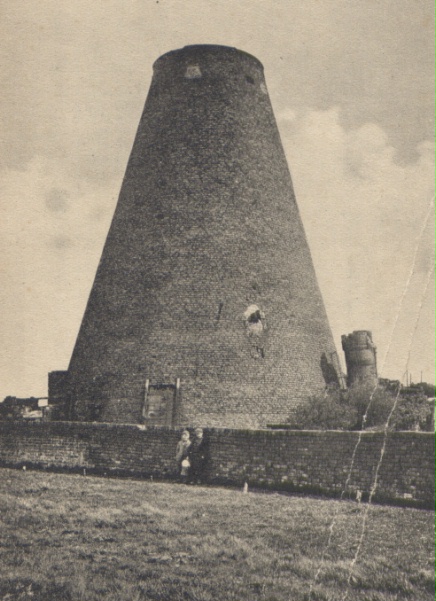
The Smelt"

Smelt, Brunswick Road, Buckley
1925
This was written in February 1966.
BUCKLEY SMELT
Buckley Smelt - the sixty-feet high, cone-shaped edifice, which has been a familiar landmark on all approaches to the town for over 175 years - is no more. It has vanished under the blows of sledge-hammers to make way for redevelopment of the area.
As the dust of the crumbling brickwork settled I visited the site in the hope of establishing further facts about the construction of what was a unique building.
In an article a few years ago, Mr. George Lloyd stated that the cone-shaped building was 60 feet high and that the diameter was 40 feet at base tapering to 15 feet at the top, where the brickwork was covered by cast-iron segments. On examination I found the thickness of brickwork at base to be three feet tapering to 2 feet 3 inches some 4 feet higher, then to 3 feet for an equal height. The walls were then 18 inches thick to halfway. The remaining 30 feet of wall was of a constant thickness of 14 inches.
Altogether it was built with some 130,000 bricks, which with jointing would weigh about 500 tons. At the time it was built, the cost of material and labour would be approximately £400 to £500 - little more than it cost to demolish it.
For lead ore.
Built by John Wilkinson, the Flemish Industrialist, the Smelt was an unusual structure, constructed to smelt the lead ore from his Llyn-y-Pandy mines, near Mold. Another building of similar shape was said by the Hawarden historian, Willett, to have been built at Pentrobin, and pulled down in 1810. This too, was for the purpose of lead smelting, and was owned by Richardson's of Chester.
Endeavours to preserve the Buckley Smelt as an example of an industrial building of its age, were made, but failed, although it had been claimed to be unique. Mr. George Lloyd claimed that the two-ton timber frame of the all-round swivel type was well over 100 years old. It is thought that Jonathan Catherall started making firebricks there in 1737 - because of plentiful local supplies of cheap coal and, in Catherall's case, of refractory clays.
The bricks.
I must confess that, apart from the Smelt itself, my interest was chiefly in the bricks with which it was built. In newspaper correspondence some months ago, I corrected a reader's statement that these bricks were Buckley Blue firebricks. It is well known that these are almost indestructible, and will outlast marble or even granite.
I ventured the opinion then that the Smelt was built with hand-made slob-bricks, made from surface clay dug in summer near the site where the bricks were to be used, and left to mature during winter. The following summer, the bricks were moulded, with the addition of water to make the clay sufficiently plastic, laid on the fields or open common to dry. Dried, the bricks were then placed in their unburnt state to form a kiln, the layers of bricks being "set" intermixed with small coal, and flues provided between the walls of bricks to form an "up-draught" kiln, stoked in provided fire-holes.
Some of the early chapels in Buckley were built with slob-bricks made in this way. On examination, the bricks of the Smelt, after exposure to all weathers for over 170 years like those of several other buildings in Buckley and district built then or even earlier, were still in sound condition - evidence of the excellent quality of hand-made bricks produced a century before machinery was introduced for their manufacture. This is, of course, in line with the historical records of such methods of brick making in early times, hence the human tribute "He's a brick!".
Not a success.
John Wilkinson's venture in Buckley was not among his many successes, and, after lead smelting ceased, this early Industrialist and armament "King" was succeeded at the Smelt by the Hancock brickmaking family, who were co-owners with Rigby of Hawarden Foundry. For many generations it was used as an iron and brass foundry chiefly for the several local brickworks.
Buckley septuagenarians will remember Jonathan Rowlands, a clever Buckley engineer who ran the Foundry for many years. It was he who designed and made the first brickmaking machines for Buckley clay which succeeded where other machines from various makers outside, had failed to deal with the refractory Buckley clay. From Mr. Rowlands, the business passed on to another old Buckley family, Beavan Brothers, who also served the local works very well for many years.
In 1933, the Hancock family sold its interest in brickworks and also disposed of the Smelt to Buckley Foundry Ltd. managed by the late Mr. Robert Fox. Hancock's had been brickmakers for over 140 years. A few years later, the present owner, Mr. Goodwin, bought the property and business and has since modernised it completely. Adapting the works to modern needs, particularly in grey castings, the present owner is operating the foundry much more extensively than ever before in its long history.
Mr. Godwin, incidentally, showed me a John Wilkinson penny of 1791, given to him by an elderly caller who did not leave his name and address. Should he read this, and pay his promised second call, the bottle of whisky Mr. Goodwin promised is still awaiting him.
Author: Griffiths, Dennis
Tags
Year = 1925
Building = Industrial
Document = Greeting Card
Landscape = Industrial
Work = Heavy Industry
Extra = 1920s
Copyright © 2015 The Buckley Society